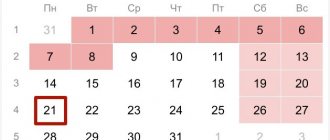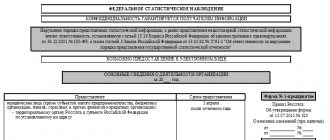Separate reporting forms for LLCs and individual entrepreneurs, mandatory for submission to the tax office, extra-budgetary funds or statistical service, contain an indicator of the average headcount. For different purposes, different types of determining the number of personnel of an organization are used:
Friends, joy! We have made a calculator to calculate the average number of employees. Use it!
- actual number;
- turnout numbers;
- staffing levels;
- planned number;
- standard number;
- average number.
Various algorithms are used to determine each value; both employees on the company’s payroll and all employees, regardless of employment status (internal and external part-time workers, temporary and seasonal workers, “contractual workers”) can be counted.
Question: What are the features of calculating the average number of employees for newly created organizations? View answer
Why do we need the average headcount parameter?
Concepts such as the planned or standard number of employed workers are mostly used in economics as a regulator of the staffing level of enterprises and are defined as the optimal number of workers required for highly productive labor at a particular enterprise.
Question: What is the penalty for failure to submit (late submission) of information on the average number of employees for the previous period? View answer
The average number of personnel (ASN) is an indicator that stands apart. It is used in special cases:
- the ability of an LLC to use preferential tax schemes (STS) depends on the indicator;
- based on the SSC parameter, the need for telecommunication networks is determined when submitting reports;
- The tax authorities calculate the average salary in an LLC based on the SCH indicator.
The SSC report is a mandatory document that is provided by all organizations and individual entrepreneurs, regardless of their organizational and legal status. The document contains information for the past reporting year.
Important: for LLCs or individual entrepreneurs registered in the middle of the reporting year, the obligation to submit a report on the average headcount begins one month after the creation of the company. At the end of the calendar year, such entities submit another report on a general basis.
A special procedure for calculating the SCH is used for LLCs registered during the reorganization measures of the predecessor organization (liquidation, re-registration). Such newly created companies must calculate the average headcount taking into account information about the employees of the previous organization.
Question: What should be indicated in the information about the average headcount if the organization employs only external part-time workers? View answer
Who should I give it to and what is it?
A report on the average number of employees (ASH) must be submitted by all organizations and individual entrepreneurs (regardless of the chosen taxation system) that had employees in the calendar year.
Newly created organizations (not individual entrepreneurs) need to submit the CHR report twice: once after creation, and the second time at the end of the year.
Individual entrepreneurs without employees, starting from January 1, 2014, do not need
.
Note!
2020 was the last year in which a CHR report had to be filed. From 2021, it is abolished by law dated January 28, 2021 No. 5-FZ. Information on the number of employees will be transmitted to the Federal Tax Service as part of the calculation of insurance premiums.
Algorithm for calculating the average headcount
The average headcount is calculated on the basis of primary documents reflecting the daily presence of employees at their workplaces. Such primary sources are:
- time sheets T-12 and T-13;
- personnel orders (on hiring, dismissal);
- orders for business trips, vacations of all types.
Question: How to take into account the only employee - an external part-time worker - when filling out Form 4 - Social Insurance Fund in terms of wages and average headcount? View answer
To fully calculate the SCN, data on all employees who are in an employment relationship with the employer are taken into account. It does not matter what type of contract is used for execution - an employment agreement/contract, a contract for temporary/seasonal work. If business owners/founders appear on payroll records, then, regardless of their employment status, information about these individuals must be taken into account in the calculations.
You need to know: all calendar days of the month are taken into account in the calculations of the MSS - including weekends and holidays. The number of working people is calculated based on the working day preceding the day off.
Workers hired on home-working terms are taken into account in the list of LLCs as full-fledged units.
Types of accounting of the number of employees. List and attendance number of employees.
We will help you write any paper on a similar topic.
- Essay
From 250 rub.
- Test
From 250 rub.
- Course work
From 700 rub.
Receive completed work or specialist advice on your educational project
Find out the cost
The formation of the workforce and working hours at agricultural enterprises depends on many conditions and factors:
1. size, structure and degree of use of land;
2. livestock, type of animal keeping;
3. level of mechanization of labor processes;
4. territorial location of production;
5. degree of development of the on-farm network;
6. opportunities to combine professions;
7. labor intensity of cultivating crops and producing livestock products;
8. the presence in the economy of auxiliary, servicing, processing auxiliary industrial production and crafts;
9. seasonality of labor use and a number of others.
To assess the movement of labor, a number of coefficients are used:
— Recruitment labor turnover rate
calculated as the ratio of the number of employees hired to the average number of employees for a certain period.
Labor turnover rate by retirement
is determined by the ratio of the number of dismissed workers to the average number of workers for a certain period.
Total labor turnover ratio
represents the ratio of the total number of hired and dismissed to the average number of employees for a certain period.
Labor turnover rate
calculated as the ratio of the number of workers who left during the reporting period for reasons characterizing labor turnover to the average number of employees for the given period.
Determining staffing needs
Number of people
(Nch) is the established number of employees of a certain professional qualification required to perform specific production, management functions or volumes of work. Based on headcount standards, labor costs are determined by profession, specialty, group or type of work, individual functions, for the entire enterprise, workshop or its structural division. The number of employees is the most important quantitative indicator characterizing the labor resources of an enterprise. It is measured by such indicators as payroll, turnout and average number of employees.
Headcount (Chsp
) employees of an enterprise - this is an indicator of the number of employees on the payroll as of a certain date or date. It takes into account the number of all employees of the enterprise hired for permanent, seasonal and temporary work in accordance with concluded employment agreements (contracts), as well as working owners of the organization who receive wages in it. Persons working under a contract and other civil law contracts are not included in the list. The list of employees for each calendar day takes into account both those who actually showed up for work and those who were absent from work for any reason (vacation, illness, business trips, etc.).
Turnout number
(Cha) characterizes the number of payroll employees who came to work on a given day, including those on business trips. This is the required number of workers to complete the production shift task for production. The difference between attendance and payroll characterizes the number of absentees for various reasons (vacation, illness, etc.). To bring the number of workers to the payroll, the coefficient for converting the number of workers to the payroll (Ksp) is used:
In discontinuous production, CSP is defined as the ratio of the standard (nominal) time fund to the planned (effective) one, and in continuous production - as the ratio of the calendar time fund to the planned (effective) one. And, conversely, to bring the payroll to the turnout, it is necessary to perform the following calculations:
Chya = Chsp / Ksp
OR
Chya = Chsp / (1/ Ksp)
When calculating, it is necessary to remember that the payroll is always greater than the attendance by the number of absent employees for various reasons.
Average headcount
— the number of employees on average for a certain period (month, quarter, since the beginning of the year, for the year). The average number of employees per month is determined by summing the number of employees on the payroll for each calendar day of the month. In this case, the number of employees on the payroll for weekends and holidays is equal to the number of employees on the previous working day.
The average number of employees shows how many employees on average were on the enterprise's lists daily for the period under review. When determining the average number of employees, employees hired on a part-time or part-time basis (part-time workers) are taken into account in proportion to the time they actually worked. Homeworkers are counted as whole units. Some payroll employees are not taken into account when determining the average payroll (women on maternity leave, additional child care leave; employees on study leave without pay, etc.).
Attention!
If you need help writing a paper, we recommend turning to professionals. More than 70,000 authors are ready to help you right now. Free adjustments and improvements. Find out the cost of your work.
Cost calculationGuaranteesReviews
Categories of employees not taken into account in the calculation of the SCH
Each LLC employee who shows up for work or is absent for a valid reason is to be included in the calculation of the average headcount. Only employees classified in the following categories are not taken into account:
- employees permanently employed in another company, working in an LLC on an external part-time basis;
- founders or managers who do not have income in the form of wages;
- young mothers on maternity leave (including child care);
- lawyers and military personnel;
- employees sent on a foreign business trip;
- students signed up for a student agreement with a scholarship;
- students and applicants on leave without pay to take the examination session;
- persons working under GPC agreements;
- employees who have announced their resignation and do not perform their job duties before the expiration of the contract.
It should be remembered: in the calculations of the SCH intended for the Pension Fund and the Social Insurance Fund, both external part-time workers and people working under civil contracts must be taken into account.
Formula for calculating MSS
To calculate the monthly average headcount, you need to know the initial data:
- duration of the calendar month (in days);
- the amount of all employees subject to accounting for a calendar month (in man-days).
The quotient of dividing the sum of man-days by the number of calendar days will be an indicator of the average headcount for the current month.
You need to know: the average headcount for a quarter, half-year or year is determined by the arithmetic average method. To do this, the monthly indicators of the SCH are summed up and divided by the number of months in the required period.
When calculating the SCH for the year for new organizations, the following rule is applied: regardless of the actual number of calendar months in which the newly created organization operated, the total number of months in the denominator of the formula is taken to be 12.
Calculation of the average number of employees for part-time work
Part-time workers should be counted separately. True, this applies only to those who were transferred to a part-time schedule under an employment contract, staffing schedule, or gave written consent to part-time work.
People for whom reduced working hours are established on the basis of law (disabled people, minors, etc.) are counted on a general basis as whole units. In addition, specialists who switched to part-time work not voluntarily, but on the initiative of the employer, are taken into account on a general basis.
Separate accounting implies that each part-time employee is counted in the average number in proportion to the time worked. The calculation algorithm is as follows. To determine the monthly indicator, you need to take the number of man-hours worked by all part-time employees in a given month. An important detail: if a person was absent on a working day due to illness, vacation or absenteeism, the number of man-hours is taken for the previous working day.
The result obtained must be divided by the length of the working day (the rules for calculating it are shown in Table 4). The result is the number of person-days for a given month.
Length of the working day depending on the length of the working week
| Length of working week | Working hours | |
| 5 day work week | 6 day work week | |
| 40 hours | 8 ocloc'k | 6.67 hours |
| 36 hours | 7.2 hours | 6 hours |
| 24 hours | 4.8 hours | 4 hours |
Next, the indicator of man-days for a month must be divided by the number of working days according to the calendar of a given month. The resulting value is the average number of part-time workers per month.
Example 6
The company operates on a five-day work week schedule. According to the staffing schedule, employee Ivanov works 4 hours a day, employee Petrov - 3.2 hours a day.
In March 2021, Ivanov and Petrov worked for 21 days.
The number of man hours in March is 151.2 (4 hours × 21 days) + (3.2 hours × 21 days)). The number of person days in March is 18.9 (151.2: 8). Based on the fact that there are 21 working days in March 2021, the average number of part-time employees for March is 0.9 (18.9: 21 days), after rounding it takes the value 1.







